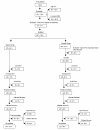Quality of life of survivors from severe sepsis and septic shock may be similar to that of others who survive critical illness
- PMID: 15025783
- PMCID: PMC420036
- DOI: 10.1186/cc2818
Quality of life of survivors from severe sepsis and septic shock may be similar to that of others who survive critical illness
Abstract
Introduction: The objective of the present study was to compare the health-related quality of life (HR-QoL) of survivors from severe sepsis and septic shock with HR-QoL in others who survived critical illness not involving sepsis.
Methods: From March 1997 to March 2001, adult patients in an eight-bed medical/surgical intensive care unit (ICU) of a tertiary care hospital admitted with severe sepsis or septic shock (sepsis group; n = 305) were enrolled and compared with patients admitted without sepsis (control group; n = 392). Patients younger than 18 years (n = 48) and those whose ICU stay was 1 day or less (n = 453) were excluded. In addition, patients exhibiting nonsevere sepsis on admission were excluded (n = 87). Finally, patients who developed nonsevere sepsis or severe sepsis/septic shock after admission were also excluded (n = 88).
Results: In-hospital mortality rates were 34% in the sepsis group and 26% in the control group. There were no differences in sex, age, main activity (work status), and previous health state between groups. Survivors in the sepsis group had a significantly higher Acute Physiology and Chronic Health Evaluation II score on admission (17 versus 12) and stayed significantly longer in the ICU. A follow-up appointment was held 6 months after ICU discharge, and an EQ-5D (EuroQol five-dimension) questionnaire was administered. A total of 104 sepsis survivors and 133 survivors in the control group answered the EQ-5D questionnaire. Sepsis survivors reported significantly fewer problems only in the anxiety/depression dimension. Although there were no significant differences in the other dimensions of the EQ-5D, there was a trend towards fewer problems being reported by sepsis survivors.
Conclusion: Evaluation using the EQ-5D at 6 months after ICU discharge indicated that survivors from severe sepsis and septic shock have a similar HR-QoL to that of survivors from critical illness admitted without sepsis.
Figures
Comment in
-
Understanding the lingering consequences of what we treat and what we do.Crit Care. 2004 Apr;8(2):103-4. doi: 10.1186/cc2838. Epub 2004 Mar 3. Crit Care. 2004. PMID: 15025769 Free PMC article.
-
Critical illness brain syndrome (CIBS): an underestimated entity?Crit Care Med. 2005 Jun;33(6):1464; author reply 1464-5. doi: 10.1097/01.ccm.0000166866.47020.e5. Crit Care Med. 2005. PMID: 15942395 No abstract available.
References
-
- Brun-Buisson C, Doyon F, Carlet J, Dellamonica P, Gouin F, Lepoutre A, Mercirer J-C, Offensladt G, Régnier B, for the French ICU Group for Severe Sepsis Incidence, risk factors and outcome of severe sepsis and septic shock in adults: a multicenter, prospective study in intensive care units. JAMA. 1995;274:968–974. doi: 10.1001/jama.274.12.968. - DOI - PubMed
-
- Pittet D, Rangel-Frausto S, Li N, Tarara D, Costigan M, Rempe L, Jebson P, Wenzel RP. Systemic inflammatory response syndrome, sepsis, severe sepsis and septic shock: incidence, morbidities and outcomes of surgical ICU patients. Intensive Care Med. 1995;21:302–309. - PubMed
-
- Alberti C, Brun-Buisson C, Goodman SV, Guidici D, Granton J, Moreno R, Smithies M, Thomas O, Artigas A, Le Gall JR, for the European Sepsis Group Influence of systemic inflammatory response syndrome and sepsis on outcome of critically ill infected patients. Am J Resp Crit Care Med. 2003;168:77–84. doi: 10.1164/rccm.200208-785OC. - DOI - PubMed
Publication types
MeSH terms
LinkOut - more resources
Full Text Sources
Other Literature Sources
Medical


